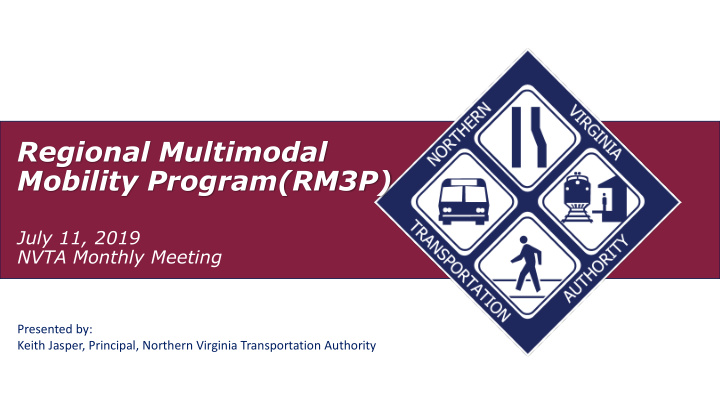



Regional Multimodal Mobility Program(RM3P) July 11, 2019 NVTA Monthly Meeting Presented by: Keith Jasper, Principal, Northern Virginia Transportation Authority
RM3P – Futuristic, but not to be confused with… C3P-O R2-D2 2
What is RM3P? • RM3P is a collaborative initiative between NVTA, VDOT and DRPT that will explore the potential for technology to complement traditional infrastructure approaches to address the Authority’s vision for TransAction, as approved in December 2015: • “In the 21st century, Northern Virginia will develop and sustain a multimodal transportation system that enhances quality of life and supports economic growth. Investments in the system will provide effective transportation benefits, promote areas of concentrated growth, manage both demand and capacity, and employ the best technology , joining rail, roadway, bus, air, water, pedestrian, and bicycle facilities into an interconnected network that is fiscally sustainable.” • RM3P will use information and communications technologies to provide travelers, commuters, service providers and transportation system operators with tools that: • Optimize system performance • Improve travel time reliability • Support on-demand multimodal trip options 3
What is the History of RM3P? • RM3P evolved from the East-West Integrated Corridor Management (ICM) project • VDOT-led initiative during 2016 and 2017, funded by FHWA, to develop an operational concept and deployment plan • ICM takes a multi-modal, multi-agency approach to dynamically manage travel conditions and traveler behavior through a corridor, including: • Route choice • Mode choice • Temporal choice • Complements an earlier ICM study in the I-95/I-395 corridor • Unsuccessful VDOT/DRPT/NVTA request for federal funding in summer 2017 • NVTA submitted a SMART SCALE application for region-wide RM3P project in August 2018 • NVTA was awarded ITTF Funding to implement RM3P 4
How Will RM3P be Funded? • Commonwealth’s Innovation and Technology Transportation Fund (ITTF): • $15M using FY2020 and FY2021 revenues • ITTF provides funding specifically for the purposes of funding pilot programs and fully developed initiatives pertaining to high-tech infrastructure improvements with a focus on: • Reducing congestion • Improving mobility • Improving safety • Providing up-to-date travel data • Improving emergency response • Projects are evaluated based on: • Contribution to innovation • Potential for transferability • Applicability across modes • Anticipated benefit • Acceptability of risk 5
How Will RM3P be Managed? • Led by Cathy McGhee, Commonwealth's Director of Transportation Innovation and Research • Project activated in July 2019 • Day-to-day management by NVTA, VDOT and DRPT staff • Kick-off with Regional Stakeholders in Fall 2019, including: • Local and regional governments and agencies • Transportation and micro-mobility service providers (public and private sectors) • Transportation system operators • Travel demand management programs • Transportation Management Associations • Military and other large employment centers • Completion Fall 2021 6
What Will RM3P Deliver? • Enhanced Commuter Parking Data. This task will target/prioritize parking lots along multiple corridors, serving commuter bus, rail, and other high demand locations. By communicating parking availability in real time, this task will facilitate carpooling, enhance access to transit, increase shared vehicle use, and reduce congestion; • Mobility as a Service (MaaS) Dynamic Service Gap Dashboard. Targeted at transportation/mobility providers, this task will encourage multi-modal travel by identifying service gaps, incentivizing MaaS activity, and facilitating first/last mile services; • AI-Based Decision Support System with Prediction. This task will use real time conditions and historic data to predict incidents and their impacts. This information will enable transportation system operators to better respond to incidents, reducing mobility impacts across the transportation system; and • Data-Driven Tool to Incentivize Customer Mode and Route Choice. This task will customize existing tools such as the free incenTrip application (developed by UMD), providing customers a range of multi-modal transportation choices. Incentives will influence travel behaviors such as route, mode, and temporal choices, balancing travel demand during both recurrent and non-recurrent congestion. 7
Other NVTA Transportation Technology Initiatives • ITS Project Investments • Annual Northern Virginia Transportation Roundtable • Transportation Technology Committee • Driven by InNoVation • TransAction Scenario Analysis 8
Recommend
More recommend